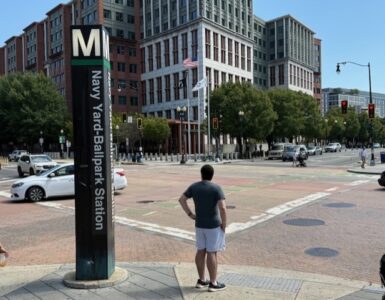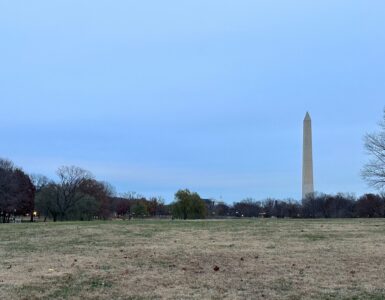By Alana Parker
Washington, D.C. is home to many journalists and professional communicators — but it hasn’t been immune to declines in local journalism. Across the country, there’s been a rise in “news deserts,” which University of North Carolina’s Hussman School of Journalism and Media defines as “a community, either rural or urban, with limited access to the sort of credible and comprehensive news and information that feeds democracy at the grassroots level.”
Nationally, over 2,100 local newspapers have closed since 2004, according to UNC’s data. In the District there’s been a 46% decrease in the number of newspapers between 2004 and 2019, along with a 53% decrease in newspaper circulation — meaning the city has lost nearly half of local papers and more than half of subscribers. Researchers at UNC warn that local newspapers have historically fostered a sense of community and grassroots democracies. Communities without them may no longer get information on political and social issues that impact residents’ lives.
“D.C. used to have so much local coverage,” said Marla Brown, a local nanny and grandmother of eight. “I used to love reading The Informer before I moved up to Baltimore to help with my grandkids. When I came back [to D.C.], it seemed like there was nothing left but the Washington Post, which isn’t even really local anymore.”
The Washington Informer has continued operations though faces the same challenges with circulation as other local papers. The Informer is one of a handful of papers that has produced news for specific and often underrepresented audiences — in this case D.C.’s Black community.
The Georgetowner, another local paper that covers the Georgetown neighborhood and the DMV area, continues to cover Advisory Neighborhood Commission meetings and community events.

Other outlets haven’t been as lucky. The Northwest Current, along with all of the Current Newspapers, closed in 2019, a loss of one of the few papers left that covered hyper local news and politics.
“I try to come to every ANC meeting I can,” said Katie Barnes in an interview. “I feel like attending them is the only way I can figure out what is going on in my neighborhood anymore.”
Barnes described how she used to read the Current and DCist, an online platform owned by NPR-affiliate station WAMU that shut down in 2023, to catch up on what she missed at ANC meetings. Now, she devotes her time to going to the monthly meetings so she can make her voice heard and better understand the happenings in her community.
“I’ve lived in D.C. for ten years now, and it’s extremely disappointing that all of this local news has seemed to just stop,” said Barnes. “Not everyone can make the time to come to these meetings. I can’t even make time to come to these meetings sometimes. We deserve local and transparent news.”
These challenges are not at all unique to D.C. According to a Pew Research Center report, newsroom employment across the U.S. declined by 26% from 2008 to 2021 — from 114,000 employees to 85,000. This decline further influences how local news and local journalists face challenges in telling important stories that communities care about, such as schools, zoning and small businesses.
As traditional forms of local journalism struggle, college newspapers have started stepping into the role of local journalists. Tyler Davis, managing news editor at The Eagle, American University’s student newspaper, described how their news team has expanded over the past two years.
“When I first started, our coverage was strictly AU-focused,” Davis said in an interview. “We’ve broadened our scope to cover stories that reflect the city we live in, not just our campus.”
Student reporters’ work is about more than just filling the gaps left by closing organizations — it’s also about creating meaningful connections with the community.
“We try to report on topics that students should care about,” Davis said. “The Metro redesign affects the N6 and 33 bus routes that students use daily. By focusing on those specifics, we make city issues resonate on a personal level.”
At George Washington University, The Hatchet has also begun to fill in gaps left by organizations like DCist and the Northwest Current. Rory Quealy, a metro news editor at The Hatchet, explained how the paper’s coverage of ANC meetings and the transformation of a former GW dorm into a homeless shelter has provided vital news to both GW students and the broader community in Foggy Bottom.
“Sometimes, we’re the only ones covering these things,” Quealy said in an interview. “It really shows the importance of having more eyes on the work done in the city.”
Quealy also noted that stories like the homeless shelter project are critical for accountability.
“The project has faced delays and lawsuits, and we’ve been there documenting every step — whether it’s zoning board decisions or legal challenges from community members,” she said. “This kind of reporting ensures that the public knows what’s happening and why.”
For Philadelphia-based freelance journalist Kate Ozypok, who has worked with outlets like The Georgetowner and Northern Virginia Magazine, the decline of local journalism has presented both challenges and opportunities.
“Freelance opportunities can fill some of the gaps left by closures,” she said. “Outlets may not have the budget to hire full-time staff, but they can afford to pay for individual stories. It’s not a sustainable fix, but it helps.”
Ozypok’s freelance work often involves hyperlocal topics, from restaurant openings to community events. She emphasized the importance of maintaining a personal touch in journalism, especially as artificial intelligence begins to play a larger role.
“AI can help with efficiency, but it can’t replicate the human connection that’s so important in local reporting,” she said. “We need people who care about these stories.”
Despite the challenges, Ozypok remains optimistic.
“Local journalism is about people — real stories, real connections,” she said. “If the next generation of journalists is passionate about it, there’s hope. But without that passion, we risk losing something irreplaceable.”
The decline of local journalism is not just a professional crisis but also a civic one. Without consistent and comprehensive local reporting, communities lose accountability, connection and their voice. This affects not only the residents of the area but also local government, nonprofits and businesses, all of whom rely on media coverage to thrive.
As Davis said, “Local journalism isn’t dying; it’s evolving. It’s more important than ever to focus on your community. The person covering a new grocery store opening is your neighbor. Local journalism is about building connections and ensuring people have the information they need to engage with their communities.”















Add comment